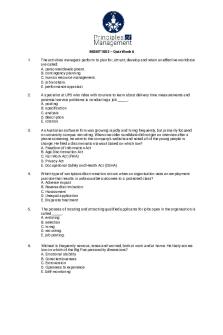Microsoft Word - Care Plan actual week 3 PDF

| Title | Microsoft Word - Care Plan actual week 3 |
|---|---|
| Author | Dashauna Jackson |
| Course | Fundamentals Of Nursing |
| Institution | Middle Georgia State University |
| Pages | 2 |
| File Size | 102.9 KB |
| File Type | |
| Total Downloads | 17 |
| Total Views | 132 |
Summary
care plan for medical surgical fall risk patient....
Description
Selected Nursing Diagnosis hypervolemia r/t excess fluid evidenced by edema in left arm. Goal/Outcome Criteria: ST goal: Client will verbalize understanding of individual dietary and fluid restrictions by end of shift. LT goal: Client will display stable fluid volume as evidence by absence of signs of edema by discharge.
Assessment Data Cluster Subjective Symptoms “client stated she was not hungry but thirsty” “client stated she was not in pain”
Nursing Interventions Assessment Interventions: Weigh client daily. Observe for sudden weight gain. Monitor intake and output. Note decreased urinary output and positive fluid balance on 24-hour calculations.
Objective Signs:
Rationale (Include Source) “One liter of fluid retention equals a weight gain of 1 kilogram (2.2 pounds).” (Ackley,et al, 2020, p. 577) “Decreased renal perfusion, cardiac insufficiency, and fluid shifts may cause decreased urinary output and edema formation.” (Ackley,et al, 2020, p. 577)
Therapeutic Interventions: Edema present in left arm Vitals stable Stats at 100% on oxygen
Encourage deep breathing and coughing exercises. Maintain semiFowler’s position if dyspnea or ascites is present.
Teaching Interventions:
Revised 8/6/2008
“Pumonary fluid shifts potentiate respiratory complications.” (Ackley,et al, 2020, p. 578) “Gravity improves lung expansion by lowering diaphragm and
Goal Evaluation ST goal met: client was in agreement and aware she was on a restricted diet to cater to fluid balances. LT goal not met: client was not able to be discharge due to fluid excess and edema still present in LA.
Evaluate client’s ability to manage own hydration. encourage foods with high fluid content.
shifting fluid to the lower abdominal cavity.” (Ackley,et al, 2020, p. 578) “Impaired gag and swallow reflexes, anorexia, oral discomfort, nausea, and changes in mentation are among factors that affect client’s ability to replace fluids orally.” (Ackley,et al, 2020, p. 579) “Relieves thirst and discomfort of dry mucous membranes and augments parenteral replacement.” (Ackley,et al, 2020, p. 579)
Revised 8/6/2008...
Similar Free PDFs

Microsoft Word - Week 6 Quiz
- 2 Pages

Care plan 3 - Care Plan
- 3 Pages

Funda CARE PLAN 1 Actual final
- 2 Pages

CARE PLAN week 7 82320 - ...
- 5 Pages

Nursing Care Plan-week 8
- 1 Pages

Makalah Microsoft Word
- 23 Pages

Makalah Microsoft Word
- 21 Pages

Trabajo de microsoft word
- 10 Pages

New Microsoft Word Document
- 22 Pages

New Microsoft Word Document
- 1 Pages

New Microsoft Word Document
- 9 Pages

New Microsoft Word Document
- 4 Pages

Microsoft Word - labo-inleiding
- 8 Pages
Popular Institutions
- Tinajero National High School - Annex
- Politeknik Caltex Riau
- Yokohama City University
- SGT University
- University of Al-Qadisiyah
- Divine Word College of Vigan
- Techniek College Rotterdam
- Universidade de Santiago
- Universiti Teknologi MARA Cawangan Johor Kampus Pasir Gudang
- Poltekkes Kemenkes Yogyakarta
- Baguio City National High School
- Colegio san marcos
- preparatoria uno
- Centro de Bachillerato Tecnológico Industrial y de Servicios No. 107
- Dalian Maritime University
- Quang Trung Secondary School
- Colegio Tecnológico en Informática
- Corporación Regional de Educación Superior
- Grupo CEDVA
- Dar Al Uloom University
- Centro de Estudios Preuniversitarios de la Universidad Nacional de Ingeniería
- 上智大学
- Aakash International School, Nuna Majara
- San Felipe Neri Catholic School
- Kang Chiao International School - New Taipei City
- Misamis Occidental National High School
- Institución Educativa Escuela Normal Juan Ladrilleros
- Kolehiyo ng Pantukan
- Batanes State College
- Instituto Continental
- Sekolah Menengah Kejuruan Kesehatan Kaltara (Tarakan)
- Colegio de La Inmaculada Concepcion - Cebu


